March 24th, 2014 §
Last fall I had grand ideas of building a cold frame to overwinter spinach, kale, chard, and salad greens. In late October, right before the first frost, I stuffed 18 strawbales in the bed of the pickup and when I got home used them to build a small fortress around some rows of greens that I’d sowed earlier in the fall.
 October 22, 2013
October 22, 2013
I made a one-and-a-half-story, south-facing design thinking that the angle would help trap the sun’s heat and shed water off the big sheet of contractor’s plastic that I draped over the top for a lid. I secured the plastic on top of the bales with some scrap lumber, bricks, and cinder blocks. It was admittedly a hot mess to look at, but that’s one reason that I hid the veg garden out of sight from the house and road!
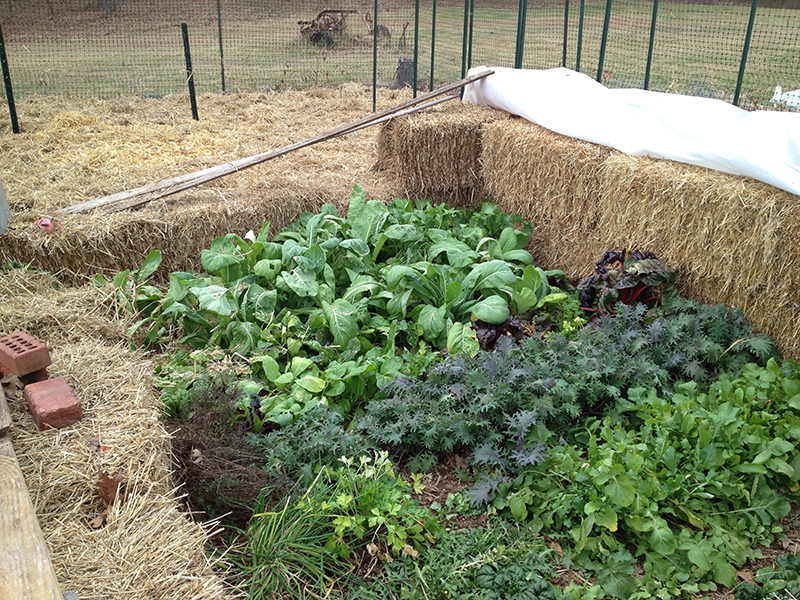 December 5, 2013
December 5, 2013
Things looked good into December, and I kept harvesting greens. But then it started to get really cold and going out to the garden to wrestle with frozen plastic and the icebergs caught in its folds didn’t appeal. So I abandoned the cold frame to the savages of this very long, cold, and snowy winter.
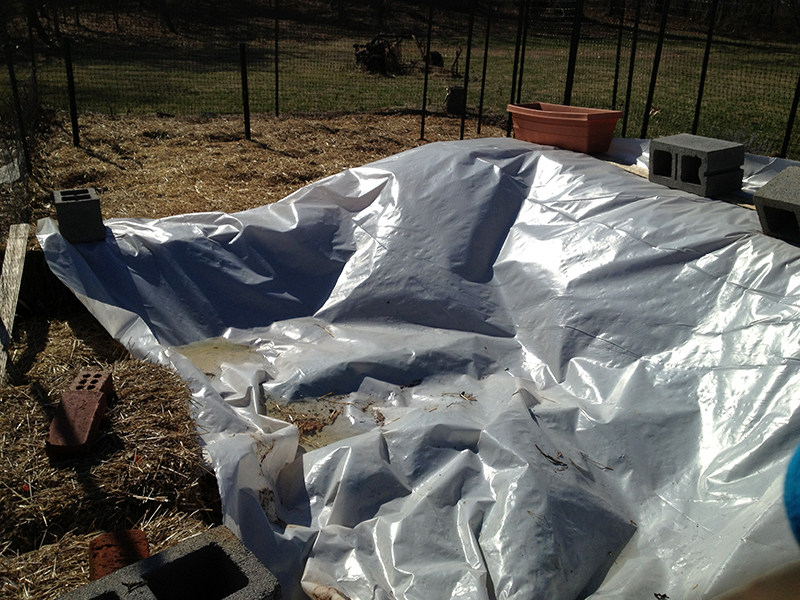
Today I thought I would peek under the plastic, and I was surprised to find quite a few plants happily growing. There were vigorous-looking weeds starting to set seed, though outside the protection of the cold frame none of these weeds are growing yet anywhere on the property—proof that I was successful at creating a little warm microclimate! I was pleased to see chicory, which is called a weed but is actually a very healthy edible spring tonic that you can add to your salad. The Red Russian kale looked pretty good, as did the spinach, and the arugula was flowering. The chard and mustard didn’t make it through as well.
 March 24, 2014
March 24, 2014
This is a happy discovery as these little plants, which have existed in suspended animation over the winter, mean a jump on the spring growing season—saving weeks of waiting for spring-sown seed to germinate in cold soil. These plants are undoubtedly strong beneath the surface, and all they will need to get up and growing is some more heat and water. After we get through this week—with more cold temps and even possible snow tomorrow—I will start opening the top of the cold frame for short spells to get the plants used to the temperatures and sun.
When it comes time to plant the whole garden, I will spread the nicely aged straw in these bales around the garden as part of my deep mulching soil-conditioning and weed-suppressing strategy.
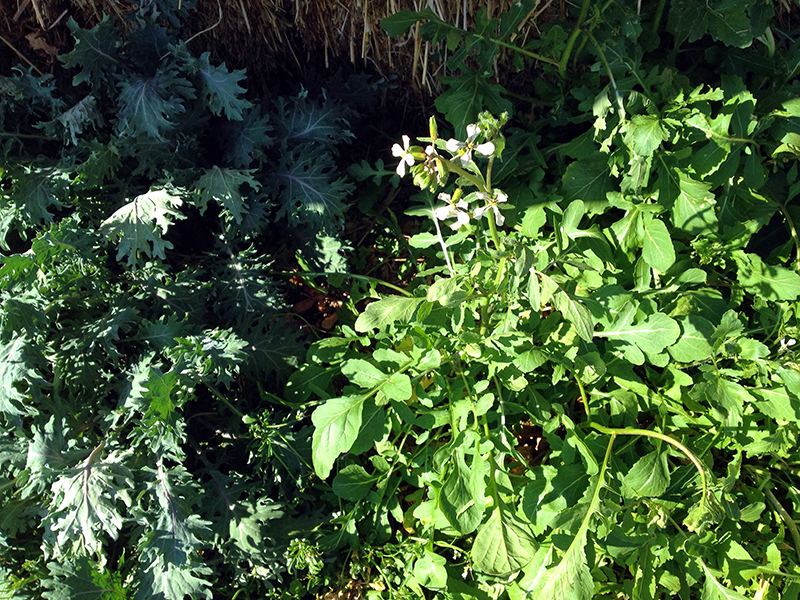
I will still probably sow some more greens from seed, just to experiment, but while I wait I will be enjoying winter-sweetened greens that amazingly hung in there through multiple polar vortices, being flattened under 16″ of snow, and everything else this winter threw at them.
I am pretty happy that what I thought was a failed experiment at getting greens to grow all winter actually isn’t a total failure. I maybe wasn’t eating lush garden-grown salad in the deepest part of winter, but I can right now, and I probably could have weeks ago had I just peeked under the plastic!
July 6th, 2013 §
We’ve had an unusual, for here, weather pattern during the last few weeks. It’s been raining almost every day, and the air is humid soup. All growing things look great, lush and happy to have all this moisture during a time when we are usually headed into summer drought. I haven’t had to water the garden once in at least a month, and most everything looks very good.
This year I am experimenting with letting some things go to seed. Chard, with its yellow feathery seedheads below, is a biennial. I planted these last year, overwintered them in pots, and now they’re in the garden working on setting seed. It’s a sacrifice to devote square footage to plants that are going to seed, but I am curious to see if I can begin to be less dependent on store-bought seed. I hope that certain things, most especially greens and lettuces, will start self-sowing in the garden, which means less for me to buy, plan and plant each year. And, once plants take control of their own growth cycles, instead of relying on a fallible gardener to tell them when to grow, they usually are much happier and healthier.

No Fourth of July ripe to tomatoes for me, but the plants are full of green fruit.
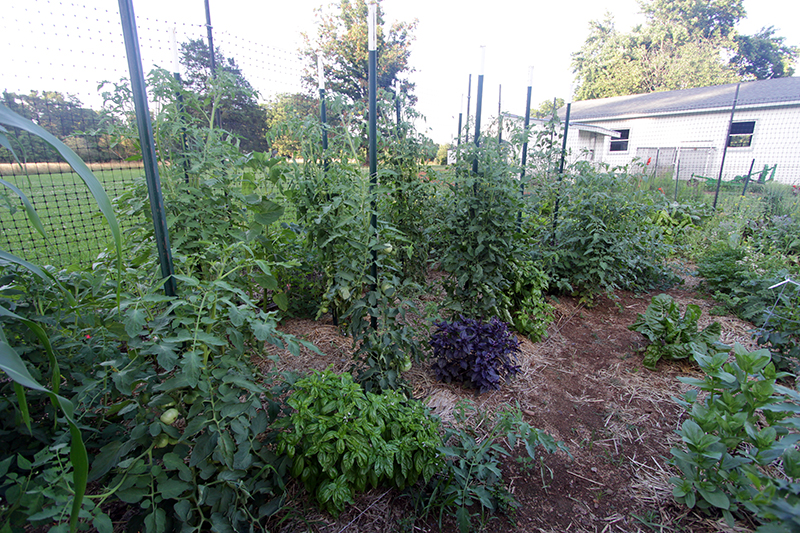
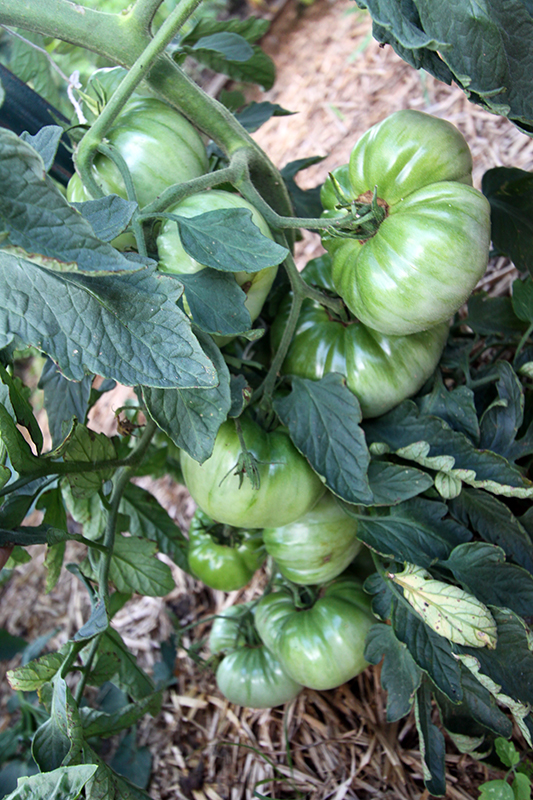
The Sun Sugar cherry tomatoes are just starting to ripen.
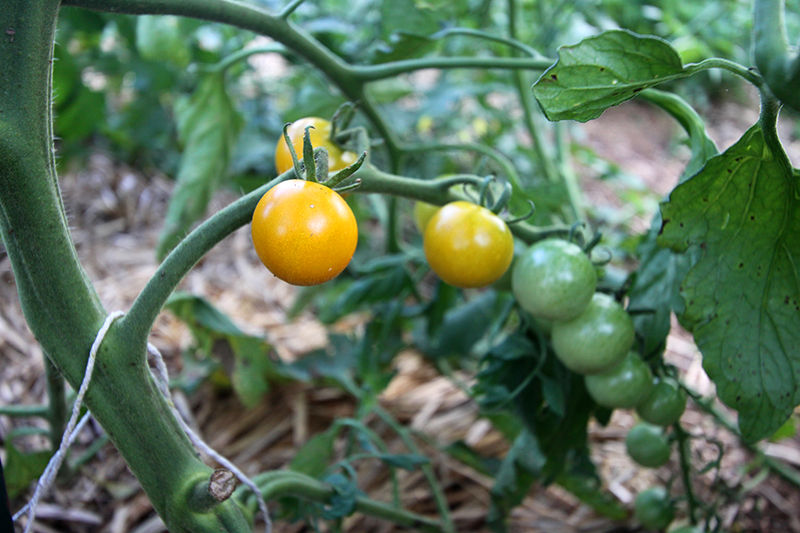
The only downside to all the rain is that it creates good conditions for diseases such a blight and fungus. You can see the beginnings of some blight at the base of this tomato in the yellowing, withered leaves with dark necrotic spots. Nothing to do but remove the affected leaves from the garden to help slow the spread. Some people use chemical sprays to control disease, but they’re an absolute last resort for me and I haven’t used them yet in this garden. Compared with some of my gardening friends, whose tomato plants are already halfway yellow, I am doing okay. I think my planting and mulching practices are paying off.

I ripped out the pea vines, which were done for the year, and planted some rattlesnake beans in their place to grow up the trellis. I have never grown these particular beans, but I hear they are pretty great. The big green plant to the right is a volunteer shiso, a wonderfully fragranced Asian culinary herb. I have no idea where the shiso came from—perhaps a neighbor—but it pops up all over my property. When I finally recognized what it was, I let it grow out everywhere as an ornamental.

I think it’s a very beautiful plant that seems to glow from within with a spiritual energy, similar to borage. It’s used in Japanese cuisine for all sorts of things. For example, the red shiso is used to make umeboshi, or pickled plums.
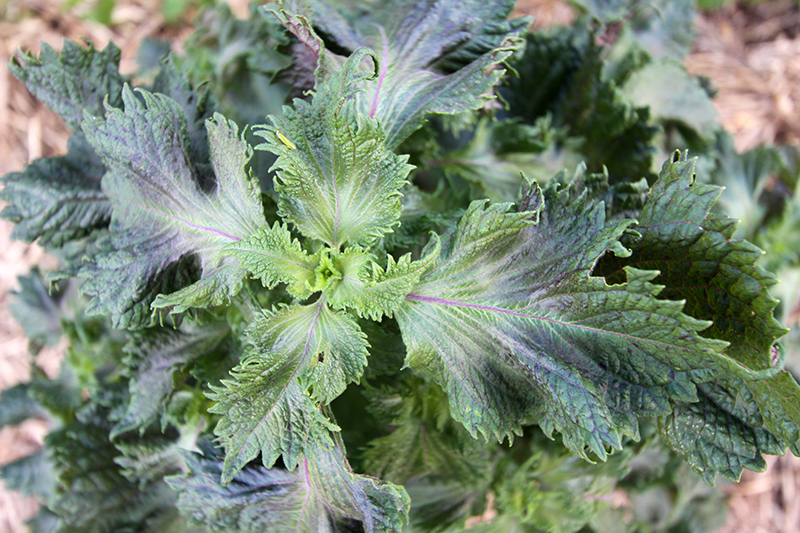
The volunteer vine that I thought was a squash turned out to be a pumpkin! Whoops! I had to cut this pumpkin off before it took down my fence. This plant may not be long for the world anyway as it appears the squash bugs have now discovered it.
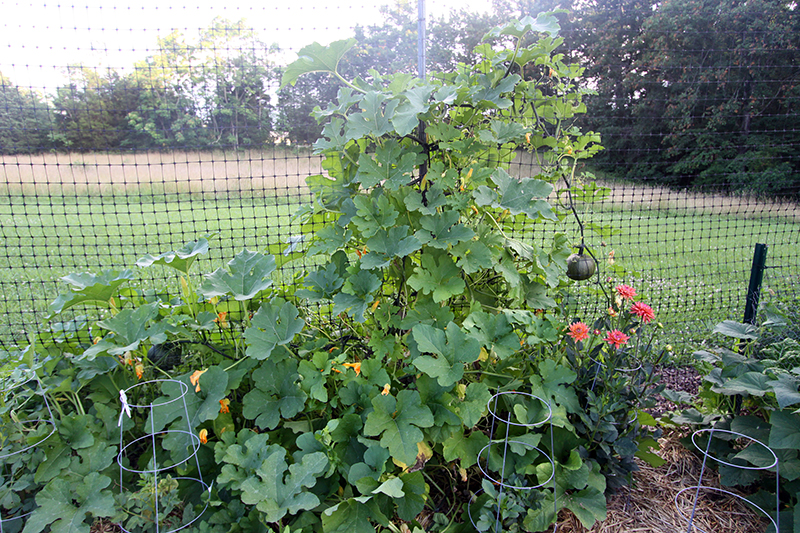
I am drowning in cucumbers. Which is kind of fun as I am on a quest to find the best refrigerator pickle recipe. Any suggestions?
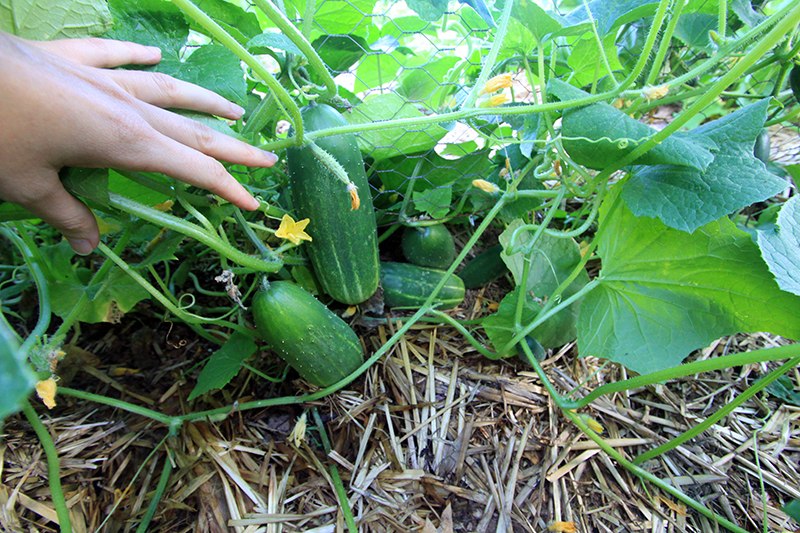
And, because it seems that cucumbers in my garden come on strong before petering out, I started a few more plants up the other former pea trellis. I planted some fun ones I haven’t grown before including an Armenian, lemon, and just another regular old bush cucumber for backup.
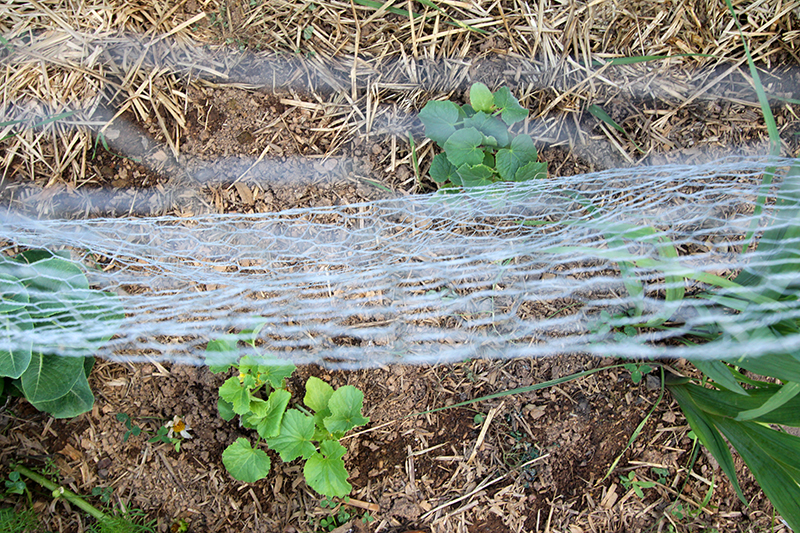
The only sweet peas to bloom from the dozens of started seeds. I think the trick to sweet peas is to plant them in the fall. Pretty pathetic. I will try that this year, as this is one flower I’d like to master.

The Japanese beetles have arrived. They aren’t too bad yet, but maybe that’s because everyone I see gets a quick thumbnail through the thorax just before its tossed to a mob of chickens.

Up next, part two of the early July vegetable garden tour…
June 7th, 2013 §
Despite how it looks, this story doesn’t have a Disney ending. Stop reading now if topics such as the natural order, predation, working farm dogs, and death are ones you’d rather not read about right now.

For the last week or so the garden around my house has been plagued by a nocturnal visitor. Every young and vulnerable plant fell victim, including new seedlings of rare, mail-ordered zinnias, the newest shoots of dozens of star gladiolus that were just emerging, small bedding coleus, and young red chard transplants that I’d been watering three times a day to get them to take—basically everything I’d lined up to provide summer interest in my garden. As any gardener knows, there is nothing more disheartening than to spend money and time fussing over young plants just to come out each morning find them eaten to the nub.

Because of the pattern of damage, I suspected a rabbit. My suspicion grew Wednesday morning when Tucker went nuts in the front garden, trying to climb inside some of the larger shrubs. I knew he was in pursuit of something, but I feared that in his frenzy I’d lose even more plants. So I called him off and kept him inside.
That night, however, he was outside with me and spent hours working something near the corner of the well house. Around sunset I went outside and found the scene above. There was no going back—the rabbit had already sustained significant damage.
I like this photo below because it reminds me of all those classic paintings of working dogs with their quarry: the labs with their ducks, spaniels with grouse and pheasant, hounds with deer and boar and bear, and terriers with ground-dwelling varmints.

Because I think it is important to reward Tucker for this hunting behavior, which is exactly the kind I want him to exhibit. So I praised him and left him with his kill. And he was oh, so proud. When I went to collect him for bed, at almost 10:00 p.m., he was crunching the last of the bones.

Yes, the rabbit was adorable and I think they are lovely creatures. I enjoy seeing them in the fields ands try my best to not hit them when they dart in front of my car. But this rabbit picked the wrong salad bar, and I am proud that I have an English Shepherd that is pulling his weight around the farm as a working dog as well as a pampered pet. Like all the happiest dogs, he has a job and it is a joy to see him able to fulfill his nature in such a helpful way.





















